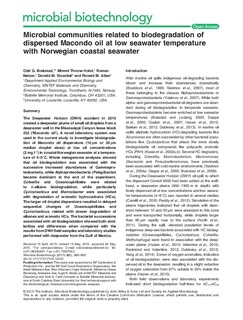Microbial communities related to biodegradation of dispersed Macondo oil at low seawater temperature with Norwegian coastal seawater
Peer reviewed, Journal article
Published version
Permanent lenke
http://hdl.handle.net/11250/2585776Utgivelsesdato
2015-07-16Metadata
Vis full innførselSamlinger
- Publikasjoner fra CRIStin - SINTEF Ocean [1387]
- SINTEF Ocean [1461]
Sammendrag
The Deepwater Horizon (DWH) accident in 2010 created a deepwater plume of small oil droplets from a deepwater well in the Mississippi Canyon lease block 252 (‘Macondo oil’). A novel laboratory system was used in the current study to investigate biodegradation of Macondo oil dispersions (10 μm or 30 μm median droplet sizes) at low oil concentrations (2 mg l−1) in coastal Norwegian seawater at a temperature of 4–5°C. Whole metagenome analyses showed that oil biodegradation was associated with the successive increased abundances of Gammaproteobacteria, while Alphaproteobacteria (Pelagibacter) became dominant at the end of the experiment. Colwellia and Oceanospirillales were related to n-alkane biodegradation, while particularly Cycloclasticus and Marinobacter were associated with degradation of aromatic hydrocarbons (HCs). The larger oil droplet dispersions resulted in delayed sequential changes of Oceanospirillales and Cycloclasticus, related with slower degradation of alkanes and aromatic HCs. The bacterial successions associated with oil biodegradation showed both similarities and differences when compared with the results from DWH field samples and laboratory studies performed with deepwater from the Gulf of Mexico. Microbial communities related to biodegradation of dispersed Macondo oil at low seawater temperature with Norwegian coastal seawater

